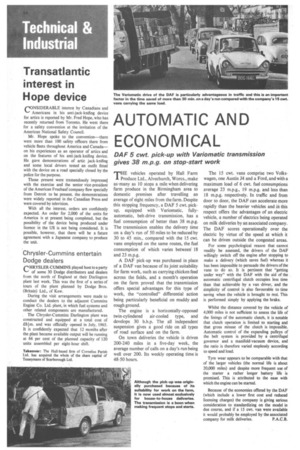AUTOMATIC AND ECONOMICAL
Page 56

If you've noticed an error in this article please click here to report it so we can fix it.
DA F 5 cwt. pick-up with Variomatic transmission gives 38 m.p.g. on stop-start work
rr HE vehicles operated by Hall Farm I Produce Ltd., Alvechurch, Worcs., make as-many as 10 stops a mile when delivering farm produce in the Birmingham area to domestic premises after travelling an average of eight miles from the farm. Despite this stopping frequency, a DAF 5 cwt. pickup, equipped with Variomatic, fullyautomatic, belt-drive transmission, has a fuel consumption of better than 38 m.p.g. The transmission enables the delivery time on a day's run of 50 miles to be reduced by 30 to 45 min., compared with the 15 cwt. vans employed on the same routes, the fuel consumption of which varies between 18 and 23 m.p.g.
A DAF pick-up was purchased in place of a DAF van because of its joint suitability for farm work, such as carrying chicken feed across the fields, and a month's operation on the farm proved that the transmission offers special advantages for this type of work, the "controlled" differential action being particularly beneficial on muddy and rough ground.
The engine is a horizontally-opposed twin-cylindered air-cooled type, and develops 30 b.h.p. The all independent suspension gives a good ride on all types of road surface and on the farm.
On town deliveries the vehicle is driven 200-240 miles in a five-day week, . the average number of calls on a day's run being well over 200. Its weekly operating time is 48-50 hours. The 15 cwt. vans comprise two Volkswagen, one Austin J4 and a Ford, and with a maximum load of 6 cwt. fuel consumptions average 23 m.p.g., 19 m.p.g. and less than 18 m.p.g. respectively. In traffic and from door to door, the DAF can accelerate more rapidly than the heavier vehicles and in this respect offers the advantages of an electric vehicle, a number of electrics being operated on milk deliveries by an associated company. The DAF scores operationally over the electric by virtue of the speed at which it can be driven outside the congested areas.
For some psychological reason that cannot readily be assessed, the drivers of the DAF willingly switch off the engine after stopping to make a delivery (which saves fuel) whereas it has been impossible to persuade the drivers of the vans to do so. It is pertinent that "getting under way" with the DAF with the aid of the automatic centrifugal clutch occupies less time than that achievable by a van driver, and the simplicity of control is also favourable to time saving when the vehicle is brought to rest. This is performed simply by applying the brake.
Whilst the distance covered by the vehicle of 4,000 miles is not sufficient to assess the life of the linings of the automatic clutch, it is notable that clutch operation is limited to starting and that gross misuse of the clutch is impossible. Automatic control of the expanding pulleys of the belt system is provided by a centrifugal governor and a manifold-vacuum device, and the ratio is therefore varied steplessly according to speed and load.
Tyre wear appears to be comparable with that of the larger vehicles (the normal life is about 20,000 miles) and despite more frequent use of the starter a rather longer battery life is promised. This is attributed to the ease with which the engine can be started.
Because of the economies offered by the DAF (which include a lower first cost and reduced licensing charges) the company is giving serious consideration to standardizing on the model in due course, and if a 15 cwt. van were available it would probably be employed by the associated company for milk deliveries. P.A.C.B.








































































































































